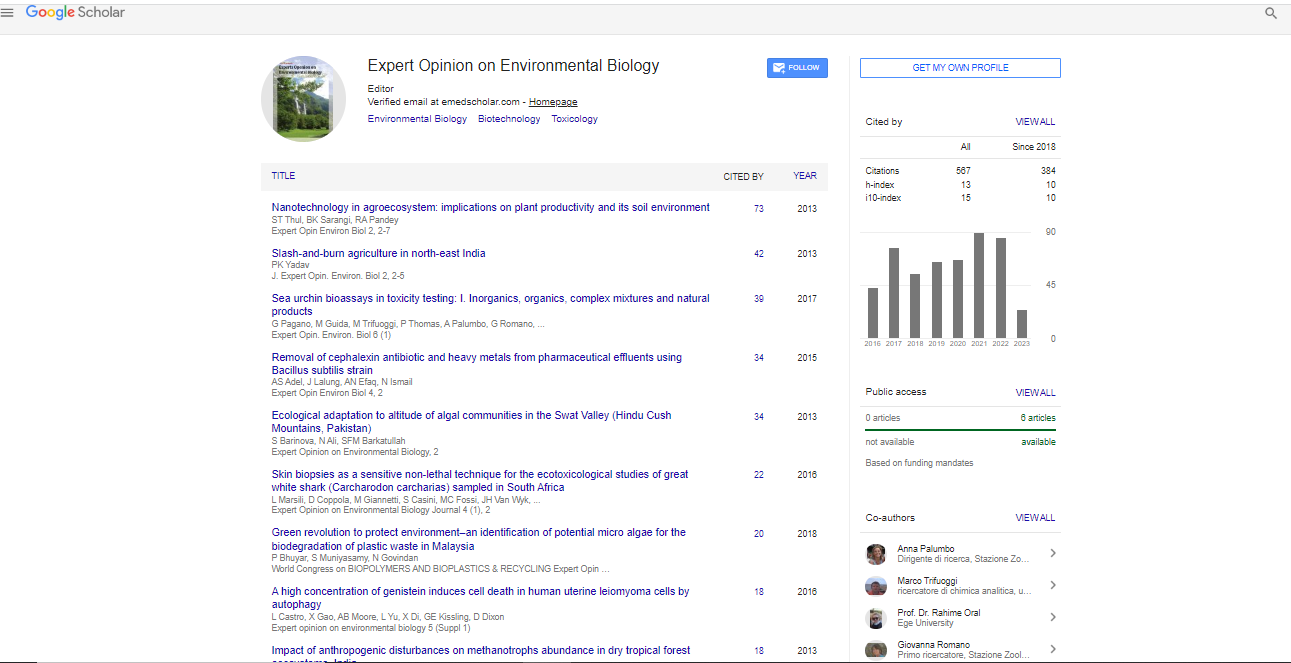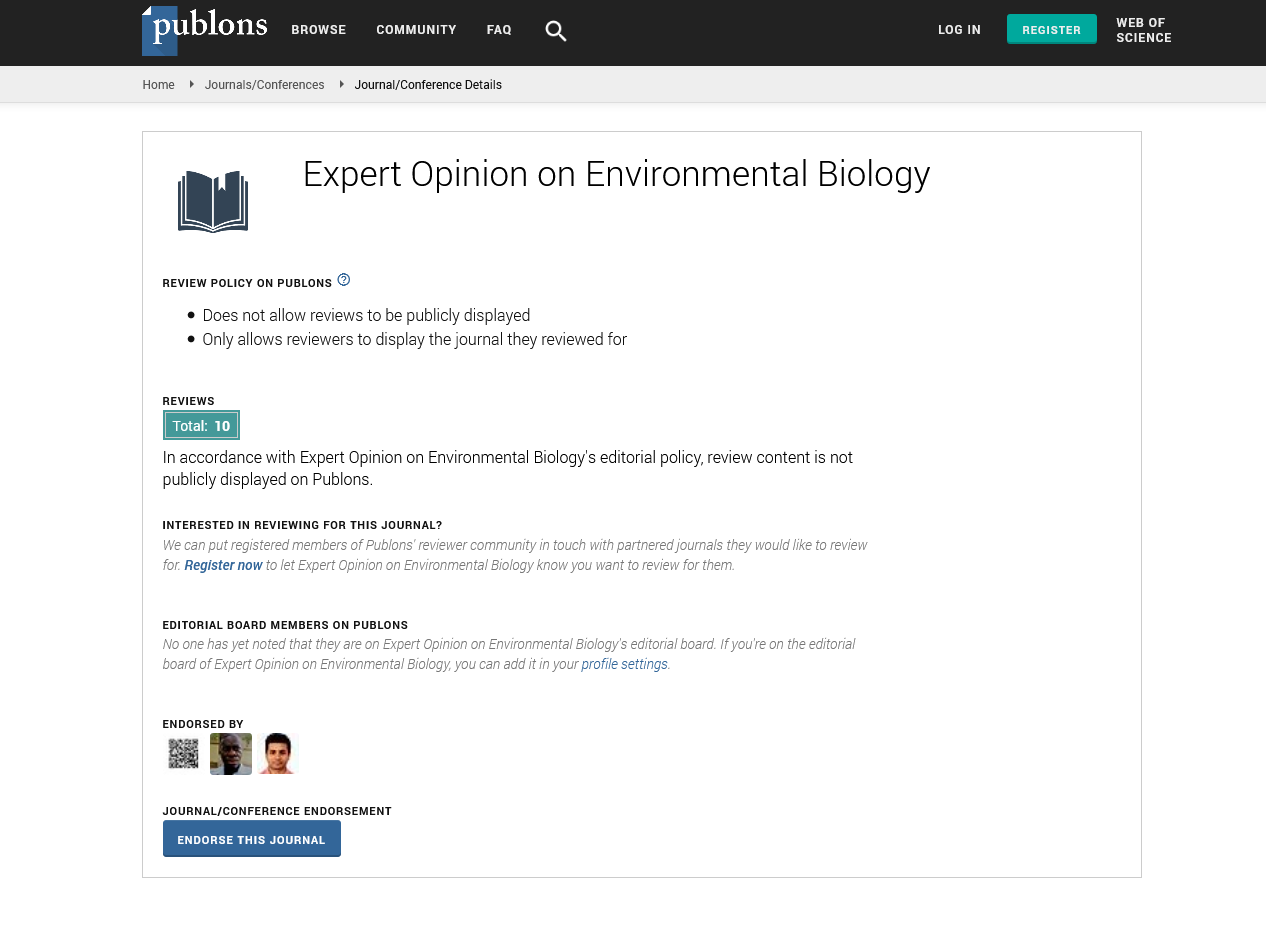Rapid Communication, Expert Opin Environ Biol Vol: 14 Issue: 1
Climate-Driven Transformations in Marine Ecosystems: Biodiversity Shifts, Predictive Insights, and Adaptive Strategies
Brinden Gleisser*
Department of Environmental Biology, Wollo University, Ethiopia
- *Corresponding Author:
- Brinden Gleisser
Department of Environmental Biology, Wollo University, Ethiopia
E-mail: brindengleiss@wues.et
Received: 01-Mar-2025, Manuscript No. EOEB-25-169979, Editor assigned: 03-Mar-2025, PreQC No. EOEB-25-169979(PQ), Reviewed: 17-Mar-2025, QC No. EOEB-25-169979, Revised: 21-Mar-2025, Manuscript No. EOEB-25-169979(R), Published: 28-Mar-2025, DOI: 10.4172/ 2325-9655.1000240
Citation: Brinden G (2025) Advancing Cardiac Healing: The Role of Stem Cells in Regeneration and Future Prospects. J Regen Med 14:1.
Copyright: © 2025 Brinden G. This is an open-access article distributed under the terms of the Creative Commons Attribution License, which permits unrestricted use, distribution and reproduction in any medium, provided the original author and source are credited.
Abstract
Climate change has emerged as a critical driver of marine
ecosystem transformations, profoundly influencing species
distribution, abundance, and ecological interactions. Ocean
warming, acidification, and deoxygenation are altering physiological
processes, disrupting trophic dynamics, and triggering habitat loss
for numerous marine species. Coral reefs, sea grass meadows, and
kelp forests are particularly vulnerable, with cascading effects on
biodiversity and human livelihoods. This article synthesizes current
knowledge on climate-induced changes in marine biodiversity,
focusing on patterns of species migration, shifts in community
composition, and resilience mechanisms. It also examines predictive
modelling approaches for assessing future biodiversity scenarios
and outlines strategies for mitigation and adaptation. Understanding
these dynamics is crucial for conserving marine ecosystems in a
rapidly changing climate.
Keywords: Climate change; Marine biodiversity; Ocean acidification; Species migration; Conservation strategies
Keywords
Climate change; Marine biodiversity; Ocean acidification; Species migration; Conservation strategies
Introduction
The oceans, covering more than 70% of the Earth's surface, play a vital role in regulating global climate and supporting biodiversity. However, the increasing pace of climate change is exerting unprecedented pressure on marine ecosystems. Rising sea temperatures, ocean acidification from increased COâ?? absorption, and reduced oxygen levels are reshaping species distribution and interactions. These changes have significant implications for ecological stability, food security, and global economic activities such as fisheries and tourism [1].
Description
Ocean warming is causing poleward shifts in species ranges, with tropical species expanding into temperate regions while cold-water species face habitat contraction. Acidification disrupts calcification processes, affecting organisms such as corals, mollusks, and some plankton species, leading to weakened food webs. Deoxygenation, often coupled with nutrient enrichment, is creating hypoxic zones that challenge species survival. Coral bleaching events, driven by thermal stress, are increasing in frequency and intensity, resulting in large-scale habitat degradation. Furthermore, migratory species such as tuna and sharks are altering their routes, influencing global fisheries distribution. Predictive models suggest that under high-emission scenarios, biodiversity losses could be severe, especially in tropical and polar regions [2].
Results
Studies indicate a 4â??6% decline in global marine species diversity per decade in vulnerable regions. Coral reef biodiversity has declined by over 50% in some areas, while polar ecosystems face disruptions in primary productivity. In fisheries, species migration patterns are already altering catch composition and economic yields. Additionally, habitat loss and degradation are reducing the resilience of ecosystems to withstand further climatic disturbances [3], [4].
Discussion
Marine biodiversity is under significant threat from climate change, with synergistic effects from overfishing, pollution, and habitat destruction exacerbating the crisis. Conservation measures such as establishing marine protected areas (MPAs), restoring degraded habitats, and reducing greenhouse gas emissions are essential. Adaptive management strategies that incorporate climate projections into fisheries regulations and biodiversity conservation plans will be vital for sustaining ocean health. Collaborative international efforts are necessary to address these challenges, considering the transboundary nature of marine ecosystems [5].
Conclusion
Climate change poses a profound threat to marine biodiversity, with far-reaching consequences for ecological balance, food security, and human well-being. Urgent action is needed to mitigate impacts through global emissions reductions and adaptive conservation strategies. Maintaining biodiversity is critical for ensuring the resilience of marine ecosystems in the face of continued climate change.
References
- Stone J, Carson A, Duncan R, Roberts R, Warlow C, et al. (2010) Who is referred to neurology clinics? The diagnoses made in 3781 new patients.Clin Neurol Neurosurg 112: 747-751.
- Gelauff J, Stone J, Edwards M, Carson A (2014) The prognosis of functional (psychogenic) motor symptoms: a systematic review.J Neurol Neurosurg Psychiatry 85: 220-226.
- Edwards MJ, Stone J, Lang AE (2014) From psychogenic movement disorder to functional movement disorder: it's time to change the name.Mov Disord 29: 849-852.
- Fahn S, Olanow CW (2014) Psychogenic movement disorders: they are what they are.Mov Disord 29: 853-856.
- Hoeven RM, Broersma M, Pijnenborg GH, Koops EA, Laar TV, et al. (2015) Functional (psychogenic) movement disorders associated with normal scores in psychological questionnaires: a case control study.J Psychosom Res 79: 190-194.
 Spanish
Spanish  Chinese
Chinese  Russian
Russian  German
German  French
French  Japanese
Japanese  Portuguese
Portuguese  Hindi
Hindi 
